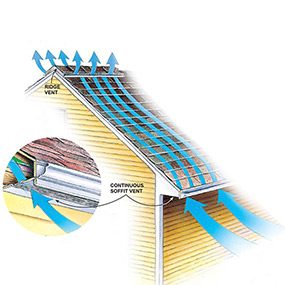
Choose your insulation
If you’re finishing your attic, insulating it to the proper R-value can cause a dramatic loss of headroom if you limit yourself to fiberglass batts. To meet all three goals—insulating your finished attic, ventilating the roof and maximizing headroom—use a combination of dense batt insulation, rigid foam sheeting and air chutes.
Most codes require a specified minimum amount of headroom, and it’s tough to meet this requirement when insulating a finished attic, especially since most codes require insulation equal to R-38 or more. However, most inspectors I’ve spoken with will lower the insulation requirement if it means that the finished space won’t have the required headroom. To get the most R-value with the least thickness, use batt insulation with higher R-value per inch in combination with rigid foam insulation. Rigid foam sheeting has an R-value ranging from R-5 to R-10 per inch of thickness. This means you can have a combined R-value ranging from R-23 to R-31 with only 5-1/2 in. of combined fiberglass and foam insulation.
Install air chutes before installing insulation

Why your roof needs air chutes
To effectively ventilate your roof, create a 1-in. airspace from the soffit to the ridge by installing a continuous air chute in each rafter bay. Air chutes, when combined with soffit vents and a ridge vent, will help prevent problems with condensation and ice dams.
“Please see an enlargement in additional information below.”
To effectively ventilate your roof, create a 1-in. airspace from the soffit to the ridge by installing a continuous air chute in each rafter bay. To install the air chutes, staple them directly to the roof decking.
Air chutes, when combined with soffit vents and a ridge vent, will help prevent problems with condensation and ice dams. They come in 4-ft. lengths and 14-1/2 and 22-1/2 in. widths. They’re readily available at home centers and they’re cheap.
Note: Air chutes work only when the rafter spaces run from the soffit to the ridge. This method won’t work where rafter spaces stop short, such as in a valley, or in the corner of a hip roof.
Video: Working With Mineral Wool Insulation
Required Materials for this Project
Avoid last-minute shopping trips by having all your materials ready ahead of time. Here’s a list.
- Fiberglass batt insulation
- Plastic air chutes
- Rigid foam sheet insulation
Additional Information
Original article and pictures take www.familyhandyman.com site
Комментариев нет:
Отправить комментарий